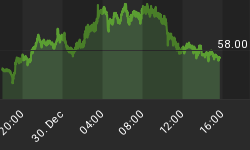Below is an extract from a commentary posted at www.speculative-investor.com on 1st January 2005.
During the second half of 2000 we devoted a lot of space in TSI commentaries to explaining why a large rally in gold stocks was just around the corner even though the darn things were stubbornly refusing to show any signs of life at the time. In this respect the past few months have felt remarkably similar because we've spent a lot of time explaining why a large US$ advance was in the cards while the dollar has been dropping on almost a daily basis.
Whenever any market has been trending strongly in one direction over a long period of time there will never be any shortage of explanations floating around as to why the trend should continue, so right now it is naturally very easy to find bearish commentary on the dollar. And this bearish commentary will often cite the dollar's poor long-term fundamentals -- primarily the large US current account deficit -- as if it were somehow impossible for a market to make a major move in the opposite direction to the one suggested by long-term fundamental factors. By the same token, it's quite difficult to find arguments to the effect that the dollar is about to begin a lengthy recovery.
However, it is not impossible for a market to trend strongly for 6-12 months or longer in a direction that appears to contradict the long-term fundamentals. In fact, it's not even improbable. Furthermore, as far as we can tell the dollar's intermediate-term fundamentals are strongly bullish. For example, the below chart comparison of the Dollar Index and the TYX/IRX ratio (the yield on the 30-year T-Bond divided by the yield on the 13-week T-Bill) illustrates one aspect of the improving interest rate backdrop for the US$.
Note that there can be huge lags between changes in interest rate trends and the associated changes in currency exchange rates. And in this particular example we've offset the charts by about 8 months to reflect the fact that this amount of time transpired during 2000-2001 between a major upward reversal in TYX/IRX and a major downward reversal in the Dollar Index. Assuming that a similar lag is occurring at the end of the trend as occurred at the beginning then the April-May downward reversal in TYX/IRX should be followed by a major upward reversal in the Dollar Index within the coming few weeks.

By the way, notice on the above chart that after the Dollar Index reached its major peak in July of 2001 it didn't immediately embark on a large decline. Rather, it fell for 2-3 months and then rebounded back to near its peak in January of 2002 before commencing a consistent downward trend. If something similar were to happen now then we'd see a major low very soon and then a test of the low around the middle of 2005 before a large advance got underway. Such an outcome would not, however, be consistent with our other market views. Therefore, a more likely scenario -- one that meshes with our other market views ? is a dollar bottom early in 2005 followed by a strong upward trend for 6-12 months in response to improving interest rate differentials and the unwinding of carry trades. The longer-term downward trend would then resume.
In addition to improvements in the interest rate differentials, reasons to expect a substantial recovery in the dollar over the coming year include:
a) Speculators, as a group, are massively short the dollar
b) Legislation has recently been passed that will allow US corporations to repatriate profits earned outside the US at a greatly reduced tax rate (5.25% instead of 35%) for a period of one year. We doubt that this legislation will be a primary driver of any dollar rally because in order to receive the tax break the repatriated money will have to be invested within the US. In other words, money is only likely to return to the US in those cases where corporations think they can achieve a higher return on investment within the US than outside the US. This, in turn, probably means that the amount of repatriated money will be a small fraction of the 500 billion dollars or so that would be eligible under the legislation. The tax break will have some effect, though, and the effect will be positive. Furthermore, we think this will be the explanation for the dollar rally that many commentators latch onto.
c) According to analysis by Dr John Hussman at
d) It's time. The current downward move began in earnest during the first quarter of 2002, meaning that it is now about 3 years old and 'long in the tooth' as far as uninterrupted declines are concerned (the dollar hasn't rallied for more than 3 months at any time over the past 3 years). The last time a consistent downward trend in the dollar lasted as long as the current one was during 1985-1987. During this prior period a relentless decline in the dollar (a relentless rally in the Swiss Franc) began during the first quarter of 1985 and ended on the last trading day of 1987. A chart comparing the 1985-1987 Swiss Franc rally with the current one is shown below.

In conclusion, the only thing that has prevented the commencement of a sustained dollar advance over the past few months has, in our opinion, been aggressive short-selling on the part of speculators. But at the end of the day the effect of this additional short-selling will be to propel the dollar upward at a faster rate than would otherwise have occurred because there is now a larger volume of short positions that will have to be unwound following a trend reversal.
















